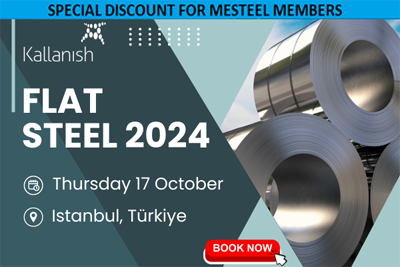
Global steel demand fell for a consecutive year in 2023 and is projected to see only a small rebound in 2024 as economies continue to grapple with the Ukraine war impact, high inflation, high costs and monetary tightening. The geopolitical scenario has deteriorated even further since the outbreak of war in Gaza and the investment climate remains shaky amid fears of conflict escalation in the Middle East. Although the EU reduced interest rates, and the US is set to follow imminently, these modest movements are unlikely to restore economic confidence.
China’s post-Lunar New Year demand failed to materialise this year, with market players still awaiting the impact of Chinese government support measures. Chinese steel exports consequently continue to climb in 2024 after seeing a seven-year high in 2023. Chinese product is displacing HRC in other Asian markets. Over the summer, multiple Chinese steel prices recorded multi-year lows.
This has resulted in the EU’s “other country” quota for HRC being exhausted within days for multiple quarters. The EU has extended its safeguard duty till 2026 and capped “other country” quota origins at 15%, severely hitting supply from Japan, Taiwan and Vietnam. The European Commission is also mulling an anti-dumping probe against Taiwanese HRC.
India is adding HRC capacity at pace, in anticipation of booming domestic demand in the medium to long term. However, Indian demand has been slow to recover from the general election earlier this year, with the monsoons suppressing activity. The country is also said to be considering a trade case against Chinese and Vietnamese HRC. Amid mill maintenance shutdowns and higher prices than EU buyers were prepared to pay, Indian coil exports to Europe have slowed considerably since the first quarter.
Vietnam, which is also considerably increasing its production capacity, has launched an anti-dumping investigation into Chinese and Indian HRC, showing clearly how strained trade relations have become this year in an environment of depressed steel pricing.
Despite attempting brief rebounds at the turn of the first and second quarters, iron ore and HRC prices have dropped across the globe this year, pushed down mainly by excess supply in China amid weak real estate and lack of stimulus. European mills are meanwhile in fear of the region’s deindustrialisation amid high production costs and persistently high imports’ share in consumption.
The major flat steel-consuming automotive sector is expected to see weak growth at best in 2024 after being the only bright spot in 2023.
Kallanish Flat Steel 2024 will debate the most important trends impacting the global flat steel market in order to understand what the industry has in store.
- Global Overview: Regional coil markets supply, demand and price trends
- Raw materials: Pricing developments and impact on flat steel market
- End-user demand: Impact of rising costs, inflation, and supply chain risks
- Overcapacity: Analysis of the longer-term global market trends
- Green transition: Challenges of sustainable steel industry decarbonisation
- Energy costs: Impact of higher energy costs on production
- China: will a demand rebound materialise? Will it cut production?
- EU production: will it rebound amid high costs?
- European policy: How will CBAM account for EU mills’ export competitiveness?
- US: Will interest rate cut boost steel demand?


